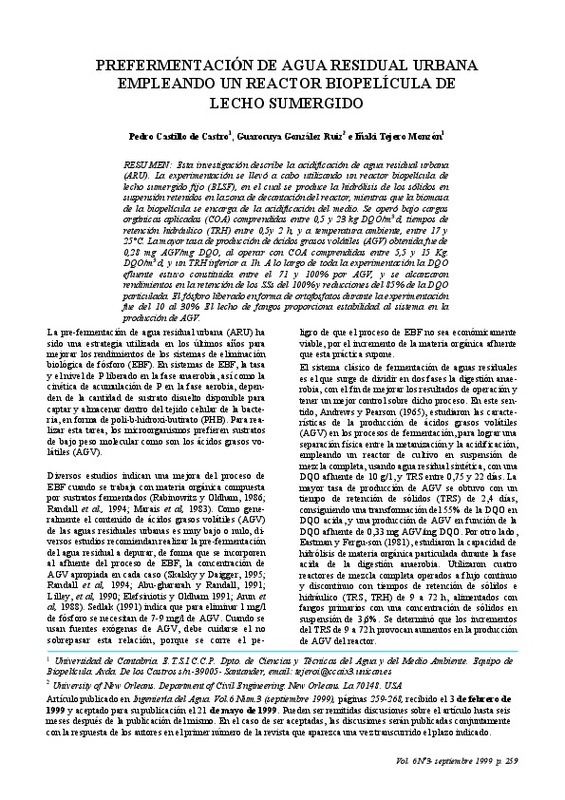Abu-ghararah, Z. H. y Randall, C. W. (1991). The effect of organic compounds on biological phosphorus removal. Wat. Sci. & Tech. 23, (Kyoto), págs. 585-594.
Andrews, J. F. y Pearson, E. A. (1965). Kinetics and characteristics of volatile acid production in anaerobic fermentation processes. Int. J. Air Water Pollution. 9, 439-461.
Arun, V.; Mino, T. y Matsuo, T. (1988). Biological mechanism of acetate uptake mediated by carbohydrate consumption in excess phosphorus removal systems. Wat. Res., 22 (5), pp. 565-570.
[+]
Abu-ghararah, Z. H. y Randall, C. W. (1991). The effect of organic compounds on biological phosphorus removal. Wat. Sci. & Tech. 23, (Kyoto), págs. 585-594.
Andrews, J. F. y Pearson, E. A. (1965). Kinetics and characteristics of volatile acid production in anaerobic fermentation processes. Int. J. Air Water Pollution. 9, 439-461.
Arun, V.; Mino, T. y Matsuo, T. (1988). Biological mechanism of acetate uptake mediated by carbohydrate consumption in excess phosphorus removal systems. Wat. Res., 22 (5), pp. 565-570.
Eastman, J.A. y Ferguson, J.F. (1981). Solubilization of particulate organic carbón during the acid phase of anaerobic digestión. Journal WPCF. 53 (3), pp. 352-366.
Elefsiniotis, P. y Oldham, W. K. (1991). The effect of operational parameters on the acid-phase anaerobic fermentation in the biological phosphorus removal process. Proceedings ASCE NATL Conf. on Environmental Engeneering. pp. 325-330.
Elefsiniotis, P. y Oldham, W. K. (1994). Anaerobic acidogenesis of primary sludge: the role of salid retention time. Biotechnology & Bioengineering.44, pp. 7-13.
González Ruiz, G. (1997). Diseño, construcción y funcionamiento de un reactor biopelicula para la pre-fermentación de Agua Residual Urbana. Tesina de Magister en Ingeniería Sanitaria y Ambiental. Dpto. de Ciencias y Técnicas del Agua y del Medio Ambiente. E.T.S. de Ingenieros de Caminos, Canales y Puertos. Universidad de Cantabria. Avda. de los Castras s/n, 39005 Santander. España.
Henze, M.; Harrenoes, P.; Jansen, J. C. y Arvin, E. (1995). Wastewater treatment. Biological and chemical processes. Springer-Verlag Berlin Heidelberg. ISBN 3-540-62702-2.
Lilley, I. D.; Wintzel, M. C.; Loewnthal, R. E. y Marais, G. V. R. (1990). Acid fermentation of primary sludge at 20oC. University of Cape Town, Water Research Commission and Foundation for Research Development. Research Report W64.
Marais, G.v.R.; Loewenthal, R.E.; y Siebritz, I.P. (1983). Observations supporting phosphate removal by biological excess uptake. Wat. Sci. & Tech. 15. pp. 15-41.
Palacios, E. (1997). Caracterización biocinética para modelización del ARU de Santander. Tesis de Magister. Universidad de Cantabria.
Rabinowitz, B. y Oldham, W. K. (1986). Excess biological phosphorus removal in the activated síudge process using primary síudge fermentation. Can. J. Civ. Eng.. 13, pp. 345-351.
Rabinowitz, B. y Oldham, W. K. (1985). The use of primary sludge fermentation in the enhanced biological phosphorus removal process. 1st. Annv. Conf. New Directions in Residual Manage. Univ. B. C. Vancouver, Canadá, pp. 347-363.
Randall, A. A.; Benefield, L. D. y Kill, W. E. (1994). The effect of fermentation products on enhanced biological phosphorus removal, polyphosphate storage, and microbial population dynamics. Wat Sci. Tech. 30 (6), pp. 213-219.
Reichert, P. (1994). Concepts underlying a computer program for the identification and simulation of aquatic systems. Swiss Federal Institute for Environmental Science (EAWAG). ISBN: 3-90484-08-4.
Sedlak, R. (1991). Phosphorus and Nitrogen Removal from Municipal Wastewater: Principles and practice. 2° De., Richard I. Sedlak Editions. ISBN 0-87371-683-3.
Skalsky, D. S. y Daigger, G. T. (1995). Wastewater solids fermentation for volatile acid production and enhanced biological phosphorus removal. Water Environment Research. 67 (2), págs. 230-237.
Speece, R.E. (1996). Anaerobic Biotechnology for industrial Wastewater. Archae Press, USA. ISBN 0-9650226-0-9.
[-]








